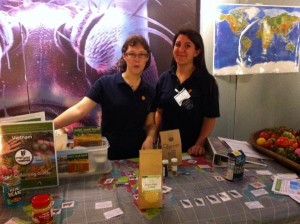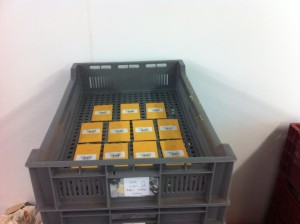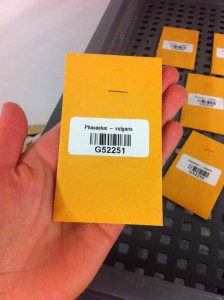Category : News
Published : November 12, 2014 - 12:40 PM
The Crop Wild Relatives team has been busy over the past few months, check out what weve been up to in our short news.
Science Uncovered Event
Dr. Ruth Eastwood (Project Coordinator) and Danielle Haddad (Communications Assistant) attended the popular Science Uncovered event at the Natural History Museum on Friday 26th September 2014. The event is held in 300 cities across Europe and provides the public with an opportunity to get up close and personal with cutting-edge science and the people who make it happen. There was an amazing array of scientific stalls ranging from all things creepy crawly to knitting your own human cells and even 3D printing of viruses! Pretty cool stuff! The project had a successful evening at the event, with a fun and engaging stall aimed at promoting and connecting with the public. The public were able to discuss and engage with us using interactive props including a world-map shower curtain, seed specimens, various varieties of vegetables and fruit, a mini-seed bank as well as a Seed Collecting Guide. Games were played with the public to find the origin of certain foods such as baked beans, millet and wheat, resulting in some very interesting answers! The atmosphere was buzzing and very inspiring with lots of really keen members of the public from various age ranges to chat with.
Incoming Seeds
On the 23/10/2014 the MSB received an exciting delivery of crop wild relative seeds from Italy and from their partner CIAT. The delivery included a selection of seeds from the genus Phaseolus that comes from the family Fabaceae which are commonly referred to as wild beans. The seeds included Phaseolus vulgaris, Phaseolus lunatus and Phaseolus leptostachyus and were placed in the dry room under quarantine, the first step of the well established system here at the seed bank, which is vital towards drying the seeds to a low moisture content to reach equilibrium and to protect the seeds against live insects. It can take several days to weeks depending on seed size to reach this equilibrium.
The seeds then made their way to the cleaning station which is done to promote the future use of the seeds and reduce disease risks. Cleaning is done carefully using a variety of methods to avoid damaging the seeds and there are many factors involved in the process including extracting the seeds from fruit or capsules. During the seed cleaning stage, seeds can also have visual checks, x-rays and cut-tests done in order to find out the overall quality of the seeds, and to determine whether some are empty, incompletely-formed or infested with insects. The tests are important to perform as any seeds that are empty or have damaged embryos will not germinate. Once the first two stages have been completed, the seeds then make their way to the cold store where they are
firstly dried to equilibrium of 15% relative humidity, then kept at -20°C which puts the seeds into hibernation mode. There are various sizes of glass jars depending on the size of seeds and amount, however, within each a small sachet of silica gel impregnated with an indicator that changes from orange to green when moist is paced that monitors the effectiveness of the container seal during storage.
After one month storage in the -20°C cold store, seeds are brought out for germination assessments which are considered to be the most reliable way to measure seed viability. Roughly 50 seeds are used for testing, but with smaller collection samples often 10-20 are used, the seeds are sewn onto petri dishes are coated with agar and information about the climatic habitat of the species is used to incubate the seeds at the right temperature. The seeds are checked weekly with any that have germinated being recorded and discarded, once germination has completed any remaining seeds are checked visually and through a cut test to determine whether or not they were full, empty or mouldy.
The information gathered during germination testing is really important because it can be used when needed to turn the seeds into plants that can then be used in research, restoration work and even reintroduction. Different species require different germination conditions and its up to the scientists based at the MSBP to unlock those conditions using their vast knowledge skills. With cwr, the assessments can take up to a few weeks to unlock the secret conditions required. Once the first germination assessment has been done, the seeds will only be brought out for re-testing every five to ten years in relation their life expectancy.
The seeds have various pathways once they have been banked, such as restoration projects, including the main purpose of the distribution of seeds to research facilities that conduct research on the samples with the aim of creating more adaptive and resilient varieties for current and future climatic challenges.
Seminars
On the 23rd of October, Dr. Ruth Eastwood held a seminar to researchers and students to Warwick Crop Centre, part of the University of Warwicks School of Life Sciences which delivers research and training for land-based industries. The talk which was much enjoyed was based on the project and the adaptation of agriculture to climate change, and highlights the need to engage more with a range of audiences.
Twitter action
We would like to take the time to say a very big thank you to all our followers, new and old for the support on Twitter which weve been busily updating. Its been so wonderful to interact with such a wide audience range and our aim is to interact more through tweeting pictures, updates, partners and international related news.
Written by: Danielle Haddad



